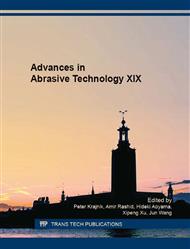p.395
p.401
p.407
p.415
p.423
p.429
p.433
p.439
p.445
Proposed Stable Machining Condition Search Method Based on Machined Surface Information after End Milling
Abstract:
Chatter vibration in end milling remains a serious problem for manufacturing engineers. Chatter vibration often leaves a characteristic pattern or chatter mark on the machined surface. Chatter marks are generated by the relative displacement of the tool and the workpiece. Closer observation of chatter marks may prove useful in understanding chatter vibration. In this study, we investigated chatter mark patterns on end-milled surfaces. Based on these observations, we proposed and demonstrated the effectiveness of an iterative analysis method to identify stable machining conditions and minimize chatter vibration in various operations without use of sensors under specific conditions.
Info:
Periodical:
Pages:
423-428
Citation:
Online since:
October 2016
Authors:
Price:
Сopyright:
© 2016 Trans Tech Publications Ltd. All Rights Reserved
Share:
Citation:


